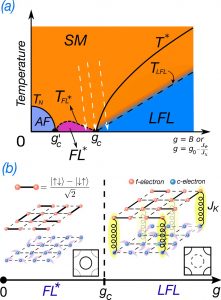College of Science Research Highlights
Prof. Chung-Hou Chung and collaborators made significant progress on the microscopic origin of un-conventional metallic state
Prof. Chung-Hou Chung of Dept. of Electrophysics and collaborators (his PhD. student Yung-Yeh Chang and the experimentalist Prof. Silke Paschen of T.U. Vienna) made significant progress in resolving a long-standing open issue on the microscopic origin of un-conventional metallic (or the “strange metal”) state, an exotic and mysterious feature that generically exists and has been observed in many correlated quantum condensed matter systems close to a quantum phase transition. This theoretical paper explains remarkably well two important but un-explained experimental works published in Nature (2003) and Phys. Rev. Lett. (2010). This research breakthrough was recently published in Physical Reve B, and has been highly acclaimed by the world-leading condensed matter physicists, including Prof. Frank Steglich (former director of Max-Planck Institute for Chemical Physics of Solids, Dresden, Germany, who made the first discovery of heavy-fermion superconductivity in 1970s’). Prof. Chung has been invited to present this work in a number of international workshops/conferences, including Energy Material Nanotechnology (EMN) workshop in Vienna, June 18-23, 2017, RIKEN-Tsinghua-Asia-Pacific joint workshop in RIKEN, Japan, Dec. 7-8, 2017.
Unconventional metallic or strange metal (SM) states, where electronic and thermodynamic observables show behavior distinct from ordinary metals, including T-linear resistivity and T-logarithmic specific heat coefficient, are generic features in various correlated solid-state systems close to quantum critical points (QCPs), including curate superconductors and heavy-fermion metals. By contrast, for normal metals at low temperatures, resistivity is proportional to the square of temperature, and the specific heat coefficient is a temperature-independent constant.
Despite of many discoveries on SM states over the recent two decades, the microscopic origin it still largely remains unexplained since early 2000s’. In this paper, Prof. Chung and collaborators address this important outstanding open issue—the mechanism of SM state in a paradigm example in Ge-substituted YbRh2Si2, a heavy-fermion Kondo metal close to anti-ferromagnetism [1]. There are two kinds of electrons in these quasi-two-dimensional layered materials: the mobile conduction d-orbital electrons, and the localized f-orbital electrons. This gives rise to two competing couplings: the hybridization between d- and f-electrons (so-called the “Kondo effect”), and the anti-ferromagnetic coupling between the local f-electrons (so-called the RKKY coupling). The system is close to a quantum critical point (QCP) when these two couplings are equally strong. In this work, a new effective field theory is constructed near this QCP based on the above competition. The strange metal state can be understood as the quantum critical behavior near this QCP. This mechanism unprecedentedly accounts remarkably well for the observed SM behaviors and the crossovers near anti-ferromagnetic QCP seen in Refs. [2,3]. The theory pushes the field on quantum criticality in heavy-fermions into a new direction.
References:
1. Yung-Yeh Chang, Silke Paschen, and Chung-Hou Chung, PHYSICAL REVIEW B 97, 035156 (2018)
2. Custers et al., Nature 424, 524 (2003).
3. Custers et al., Phys. Rev. Lett. 104, 186402 (2010)
Abstract Link: https://journals.aps.org/prb/abstract/10.1103/PhysRevB.97.035156

Figure 1. (a) Schematic phase diagram of Ge-substituted YRS. (b) Schematic plot describing the competition between the RVB spin-liquid (FL*) phase and the coexisting Kondo plus spin-liquid (LFL) phase near QCP (gc ) at zero temperature.